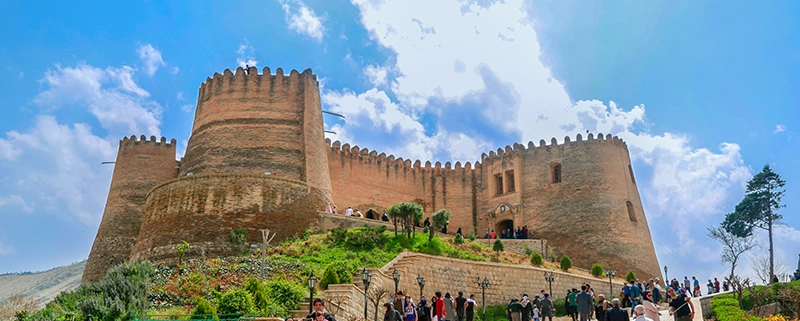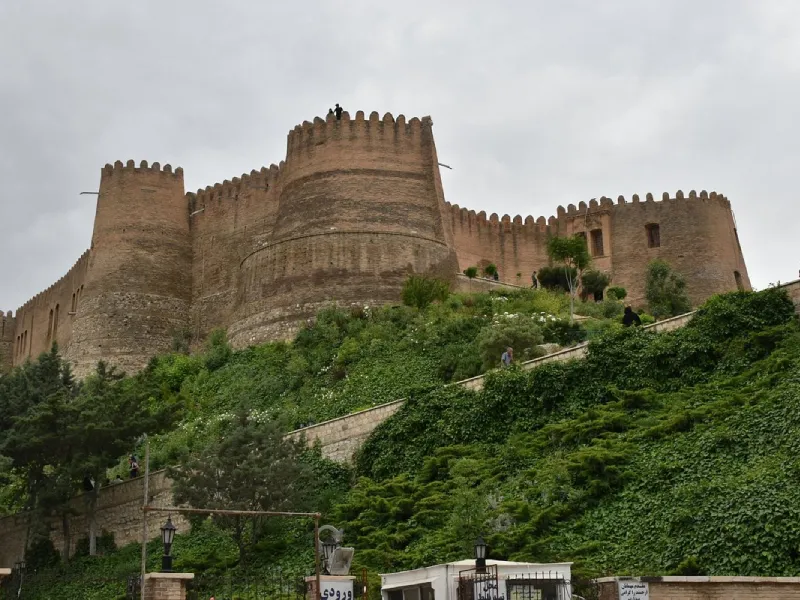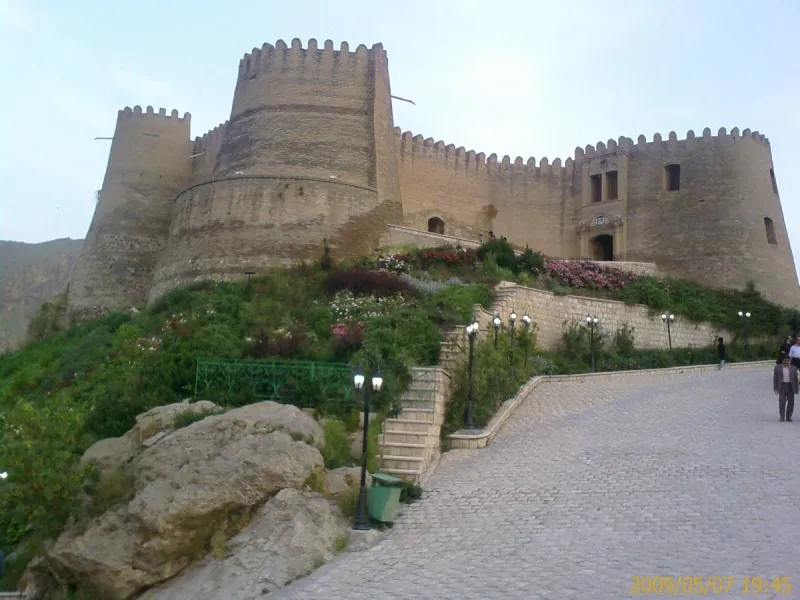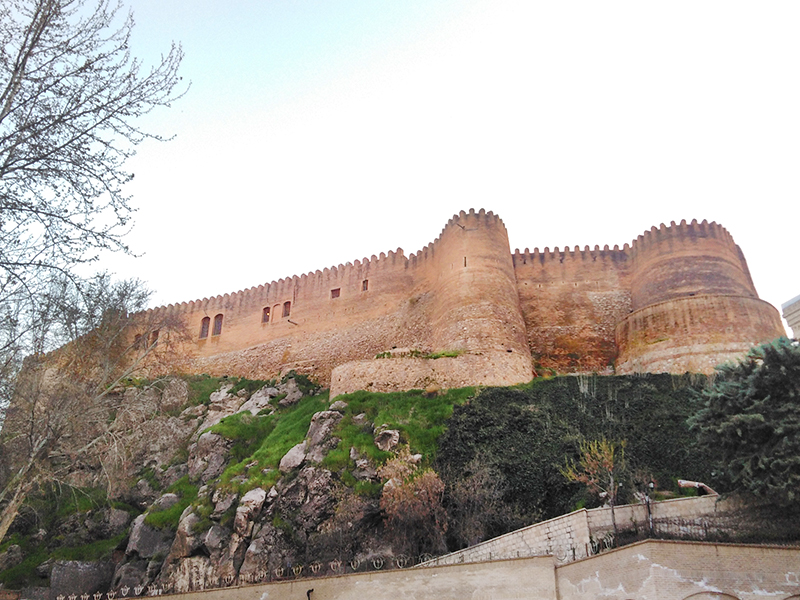Falak-ol-Aflak Castle (Shapur Khast): History, Photos
In the heart of the city of Khorram Abad stands Falak-ol-Aflak, a prominent ancient castle belonging to the Sasanian Empire, which ruled from 224 to 651 AD. Falak-ol-Aflak Castle is one of the most esteemed historical monuments left intact from ancient Iran. This castle was used as a prison and a governmental fortress. Nonetheless, Falak-ol-Aflak Castle was also the residence of many rulers from various periods, such as Sassanid, Buyid, Safavid, and Qajar. If you are interested in this historical treasure, stick with us for more.
Falak-ol-Aflak History
Since the distant past, Lorestan province was the focus of many Iranian rulers due to its abundant springs and watercourses and lush nature. The renowned historical castle, situated in the center of Khorram Abad city of Lorestan province, is built on top of a hill by a river overlooking Khorramabad.
Falak-ol-Aflak Citadel (Shapur Khast)
How old is the Falak ol-Aflak Castle? The castle dates back to the Sassanid era. During the Sassanid period, “Shapur I” ordered the construction of a city called “Shapurkhashat” in the area now called Khorramabad city. Flak ol-Aflak Citadel is the Shapurkhashat Fortress, which was used for government and military purposes during that period and was even used as a prison for Roman prisoners.
In 300 AD, the government fortress or prison of Falak-ol-Aflak Castle became the seat of the ruler of Lorestan Hasanwayh of the Hasanwayhids dynasty (a powerful Shia Kurdish dynasty). This castle was used again during the time of Buyid period, and the rulers and royal families used Falak-ol Aflak as a treasury. Moreover, during the Qajar period, the castle was rebuilt, and during the Safavid, Qajar, and even Pahlavi periods, Falak-ol Aflak was used as military barracks and a political prison.
The castle was used as a prison until 1968, and later in the era of the Pahlavi dynasty, Falak-ol Aflak was transformed into a museum complex for visitors.
Falak-ol-Aflak Architecture
Falak-ol Aflak boasts an intricate structure with deep hidden meanings behind it and is truly an architectural masterpiece of Iran. The reason for building Falak ol-Aflak castle high above the city of Khorram Abad is that it is made with different materials like stone and wood that are vulnerable to humidity. This allowed the wind to penetrate the building and dry its foundations.
The Brickwork
The overall shape of the citadel is a pentagon, and its towers have different measurements. The walls of the castle are made of limestone and moisturized organic materials. Simple brickwork can be seen on all surfaces and facades. There are no plaster or tile decorations in any part of Falak-ol Aflak Castle.
To further protect the walls of the castle, wooden coiling is used. Even though the brickwork looks simple, the bricks are stacked like a rhombus and in an intricate fashion. Some underground passages have been dug inside the castle to drain water. The tallest wall in this castle is 33 meters and has an irregular octagonal plan.
The Moat
In the establishment of the ancient castles of Iran, the method of construction of defensive fences was significant in the architecture of the monuments. The castle has been used as a government fortress in different historical periods. For this reason, the defense walls of the river coastline in the southeast, with an area of 10 hectares, have surrounded this fortress. The Khorram Abad River also protected the fortress, serving as a moat in the southern part of Falak-ol-Aflak castle.
The Gates
Two main gates of Falak-ol Aflak named “Gerdab” leading to the Kermanshah Caravanserai and “Khuz” on the right path of Khorram Abad River were the entrance roads to Khorram Abad city.
Three gates named “Darwaze Shahr” and “Darwaze Pol” on the northern part of the castle and “Darwaze Qal-e” In the south of the fortress provided access to the castle.
The Interior
The entrance of Falak-ol-Aflak Castle has two large brick towers, and an archway is located in the northwest part of this area. The architectural style of this part of the castle belongs to the period of the Qajar Dynasty. The guard rooms, the entrance hall, and the first tower of Falak Al-Aflak Castle are situated in this section.
There are several buildings constructed within the citadel, and one of the buildings is referred to as Golestan Mansion, where the Andaruni (women’s quarters or Harem), courtyard, bathrooms, mosque, gunnery, and Divankhana were located. This building was considered the only two-story building in this castle that had an entrance to the castle from the outside.
By passing through the entrance and the vestibule, you will reach the first courtyard of the castle. In the southern part of the first courtyard, a row of buildings can be seen, which were rebuilt after the destruction of the second tower. Beyond these buildings, there is a rectangular building with six columns that hold a dome on the roof of the monument.
The 12 Towers of Falak-ol Aflak
If you take a look at Falak-ol-Aflak Photos, you will not see these 12 towers. Archaeological studies have identified the existence of twelve towers around the current construction. There were 14 towers in the corner of the citadel, two of which were watchtowers.
The secret behind the 12 towers is that each tower was associated with each 12 zodiac signs. However, of these twelve original towers, only two of them have remained and are situated northwest and southwest of the surviving fortress.
The Mystery of Falak-ol-Aflak
Flak Al-Aflak Castle is one of the most mysterious ancient monuments from different historical periods, and archaeological excavations and experts’ investigations over time have proved that the castle bears many secrets.
One of the most important factors in the construction of ancient castles was the proper access to drinking water sources for the inhabitants of the castle. Experts have come across traces in Falak ol-Aflak Khorramabad that strengthen the possibility of the existence of an aqueduct under it. Although this hypothesis has not been proven yet, it cannot be completely neglected.
The well of this castle is shallow, and the original constructors have dug it vertically. The depth of this well reaches more than 40 and a half meters, which is located in the northeast of the first courtyard, behind the long arch. Today, the source of the water of this well is said to be the surrounding river, but there is also the possibility of an aqueduct.
Falak-ol-Aflak Museum
One of the halls of the Flak Al-Aflak Museum displays the statues of the masters of traditional professions of ancient Lorestan. Visiting this section shows the skills of Lorestan masters in making handicrafts. In the halls, indigenous and nomadic weavings and replicas of Lorestan women weaving carpets and curtains are displayed very elegantly. But one of the most beautiful parts of this museum is its music hall, which shows the close connection between music and the people of this region.
In this section, all kinds of traditional instruments of Lorestan, such as Sorna, Karnay, and Dozaleh, and various percussion instruments of this region, such as Dohol, and stringed instruments, such as Tanbur and Kamancheh are exhibited in the Museum of Falak-ol Aflak.
Falak-ol-Aflak Ticket Price
Falak-ol Aflak Castle is open from 9 Am to 8:30 Pm. The castle is closed on public holidays. Please note that apart from the entrance fees, tickets to museums of the castle are sold separately to visitors. Museums are closed on Mondays.
The entrance fee for Foreigners is 1,500,000 Rials/ 150,000 Tomans.
Final Word
This ancient Falak-ol-Aflak Castle is a popular tourist attraction of Khorram Abad. This historical building is considered one of the most important and valuable historical works of Khorram Abad, with its magnificent architecture that has been preserved since the Sassanid period. Today, this castle has become a museum and welcomes many visitors from all over the world. You can visit this castle and discover about the works of the ancients and learn about the culture of the people of Lorestan. In addition, you can also watch the spectacular view of Khorram Abad city from the top of this castle.
If you plan to visit Iran, here is the link to Iran visa and our Iran tours.









Leave a Reply
Want to join the discussion?Feel free to contribute!